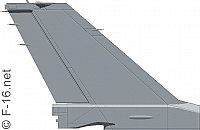 |
F-16 ESEnhanced Strategic |
Structural Modifications
The proposed extended-range F-16ES (Enhanced Strategic) version of the Fighting Falcon was originally developed for the Israeli strike fighter competition. In order to provide increased range, conformal fuel tanks which hold an extra 3,200 lb. of fuel were to be fitted. When combined with a 320-gal. centerline tank and two 600-gal. underwing tanks, the F-16ES has an unrefueled mission radius of 1,025 mi. when carrying a typical strike load of two 2,000-lb. bombs and four air-to-air missiles. That represents a 40% increase over the range of the current U.S. Air Force block 50 F-16C and is roughly equivalent to that of the F-15E, according to Lockheed. However, this project lost out to the McDonnell Douglas Strike Eagle in the competition.

In addition to the conformal fuel tanks, the F-16ES also features an internal forward-looking infrared (FLIR) system, which basically replicates the capabilities of the LANTIRN navigation and targeting system without the drag associated with external pods. Following the loss of the Israeli strike fighter competition to the F-15I Strike Eagle (the Israeli export version of the F-15E), Lockheed has resurrected the project following an expression of interest by several other nations. A.o., Lockheed offered the F-16 block 60 (sometimes referred to as the F-16U) to the United Arab Emirates. It includes the conformal fuel tanks and the internal FLIR.
Flight Testing
Lockheed Ft. Worth Co. began flight-testing with a leased block 30 F-16C (#83-1120 ED) fitted with the shapes representing the conformal tanks and one of two external FLIR turrets (the lower ball turret). The aircraft first flew on November 5th, 1994 and has completed flight testing in January 1995. A total of 21 flight test were conducted after a rapid-prototyping program to gather aerodynamic data on the external features of the F-16ES. Seventeen flights were geared toward evaluating the aircraft's handling characteristics with two 24-ft. conformal fuel tanks. According to these tests, departure resistance and recoverability changes seemed minimal. The remaining four tests focused on the impact on inlet air flow and engine operability of a lower ball turret for a nose-mounted, internal FLIR system. The F-16ES also features an upper ball turret for the internal FLIR system, which was evaluated in a previous program.
Please use this form to add any list any error or omissions you find in the above text.
Note: your comments will be displayed immediately on this page. If you wish to send a private comment to the webmasters, please use the Contact Us link.
